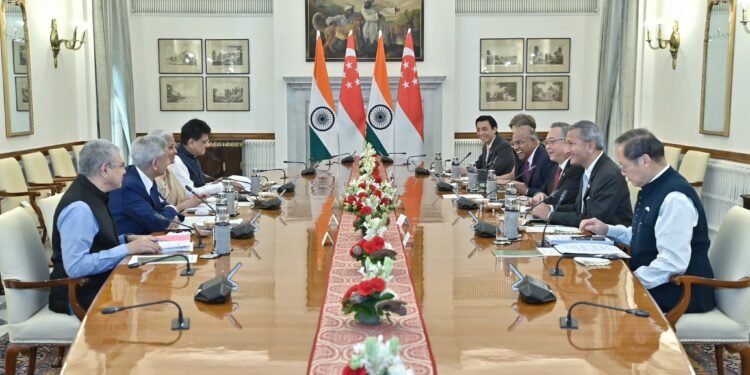NEW DELHI: The recently concluded 3rd India–Singapore Ministerial Roundtable in New Delhi marks far more than a routine diplomatic exercise. This high-level engagement bringing together India’s External Affairs Minister S. Jaishankar, Finance Minister Nirmala Sitharaman, Commerce Minister Piyush Goyal, and IT Minister Ashwini Vaishnaw with Singapore’s Deputy Prime Minister Gan Kim Yong and his ministerial team, signals the emergence of a new geoeconomic axis. Their agenda, spanning digital ecosystems, advanced manufacturing, and sustainable infrastructure, offers a tangible template for South–South cooperation at a time of geopolitical flux.
Since the 2022 Comprehensive Strategic Partnership, India and Singapore have built something potentially transformative, an operational model for economic governance that challenges Western institutional dominance without replicating the debt-laden traps associated with Chinese projects. Singapore’s adoption of India’s UPI payment system and collaboration on semiconductor manufacturing, exemplified by the Tata–ST Engineering venture, demonstrate how this relationship is reshaping real supply chains and digital architectures, not just producing joint statements.

This deepening partnership unfolds against a backdrop of strategic recalibration across Asia. Singapore continues to walk a fine line between U.S. and Chinese interests, while India intensifies its Quad engagements even as it participates in China-led platforms like the SCO. Together, they represent an increasingly coherent “third way” for middle powers, offering developing nations a credible alternative to the polarizing choices presented by Washington and Beijing. India’s SAGAR maritime doctrine, combined with Singapore’s logistics prowess, could prove particularly attractive to countries wary of both superpowers’ conditionalities.
The timing is particularly significant. On August 18, Chinese Foreign Minister Wang Yi will visit India for talks under the Special Representative mechanism, the highest-level bilateral dialogue on the protracted border dispute. His trip comes just weeks before Prime Minister Narendra Modi’s planned visit to China for the SCO Summit, his first since the 2020 Galwan clash. While the border standoff remains unresolved, this careful diplomatic re-engagement suggests India is willing to keep communication channels open even as it strengthens ties elsewhere.
Almost immediately afterward, on August 21, Jaishankar will head to Moscow for talks with his Russian counterpart, Sergey Lavrov, to reinforce a relationship that still delivers critical energy supplies and defense cooperation. This will set the stage for President Vladimir Putin’s expected India visit later this year, underlining New Delhi’s ability to maintain diverse partnerships in a fractured global landscape.
What emerges from this diplomatic choreography is a distinctly Indian playbook: using Singapore as a hub for technology and trade diversification, leveraging Russia for energy and defense resilience, and cautiously probing areas of overlap with China, all while safeguarding strategic autonomy. It is less about “non-alignment 2.0” and more about “multi-alignment,” with each relationship advancing a specific component of national capability.
Early results are promising. Singapore-backed initiatives in Gujarat’s GIFT City are evolving into credible competitors to Hong Kong’s financial hub. Russian-backed energy arrangements have cushioned India from OPEC+ price shocks. Even limited engagement with China could reduce the risk of miscalculation along the Line of Actual Control. If these strands can be woven into a coherent whole, India could shift from being a “swing state” in the global order to an architect of its multipolar foundations.
With the West distracted by internal crises and China’s growth model under visible strain, the India–Singapore vision of tech-enabled, sustainable development stands out as a pragmatic and politically unaligned path for the Global South. In this light, the New Delhi roundtable may be remembered not as an isolated event, but as the institutional expression of a larger awakening, one in which India claims not just a seat at the table, but a hand in designing it.
– Dr. Shahid Siddiqui; follow via X @shahidsiddiqui
WATCH, LIKE & SUBSCRIBE CHANNEL FOR VIDEO STORIES





















